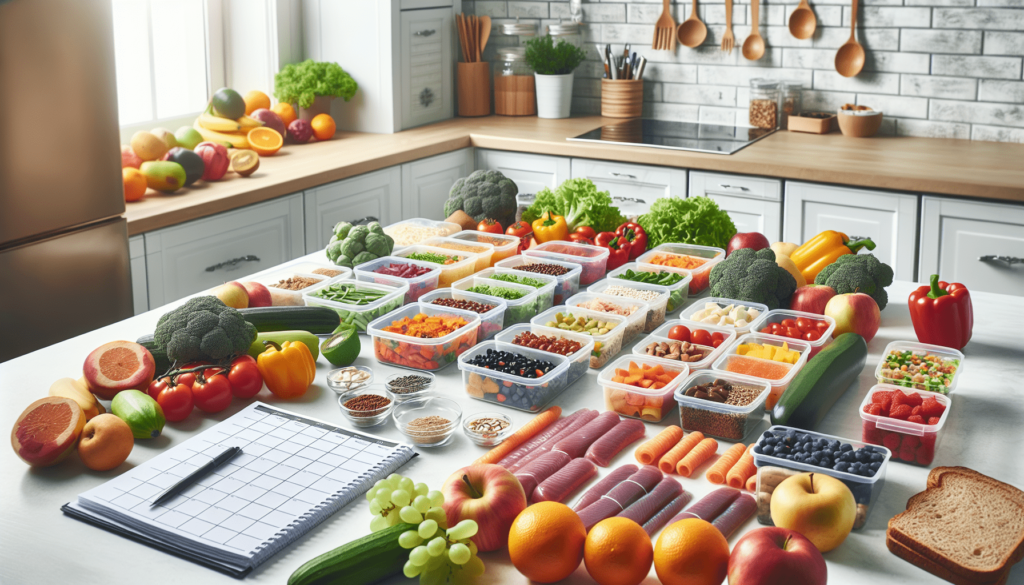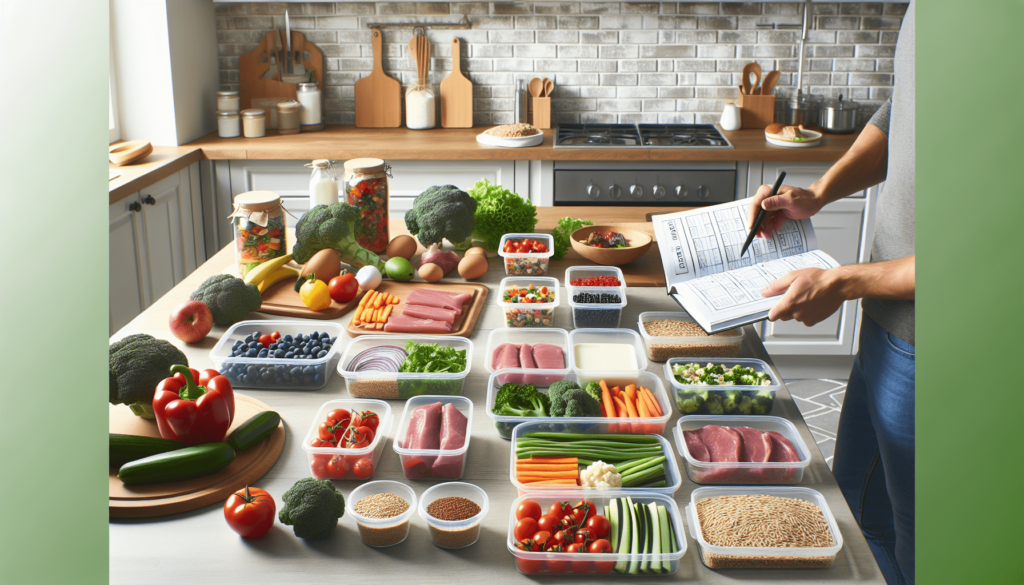Are you tired of constantly scrambling to find something healthy to eat amidst your busy schedule? Look no further, because meal prepping is here to save the day! This article will provide you with valuable tips and tricks to help you succeed in meal prepping for healthy eating. From planning your meals in advance to organizing your kitchen, we’ve got you covered. Get ready to say goodbye to last-minute and unhealthy food choices, and say hello to a healthier and more convenient way of eating.

Start with a Meal Plan
When it comes to meal prepping, the first step is to create a meal plan for the week. Planning your meals in advance not only saves you time and stress, but it also helps you make healthier choices. Start by considering the number of meals you’ll need for the week, including breakfast, lunch, dinner, and any snacks.
Include a variety of fruits, vegetables, lean proteins, and whole grains in your meal plan. This ensures that you’re getting a balanced mix of nutrients and flavors. Consider any dietary restrictions or preferences you might have, such as vegetarian or gluten-free options. By taking these factors into account from the start, you’ll be able to create a meal plan that suits your needs and tastes.
Make a Shopping List
Once you’ve planned your meals for the week, it’s time to create a shopping list. Write down all the ingredients you need for each recipe, making sure to include quantities for each item. This will help you stay organized and prevent you from forgetting any essential items.
When you go grocery shopping, stick to your list to avoid impulse buys. It can be tempting to pick up extra items that catch your eye, but this can lead to unnecessary spending and food waste. By sticking to your list, you’ll not only save money but also stay focused on your goals.
Before heading to the store, check your pantry and refrigerator for items you already have. This will prevent you from buying duplicates and ensure that you use up what you already have on hand. It’s a great way to avoid waste and make the most of your ingredients.
Shop Smart
When it comes to meal prepping, shopping smart is key. Choose fresh, seasonal produce whenever possible. Not only is it more flavorful, but it’s also often more affordable. Look for lean cuts of meat and low-fat dairy products to keep your meals healthy. Opt for whole grains like quinoa, brown rice, and whole wheat pasta to add fiber and nutrients to your dishes.
One of the most important aspects of shopping smart is to avoid processed and sugary foods. These can be tempting to grab for quick and easy meals, but they often lack the nutritional value your body needs. Instead, focus on whole, unprocessed foods that will nourish your body and support your overall health.

Prep the Ingredients
To make meal prepping even easier, it’s important to prep your ingredients in advance. This includes washing and chopping fruits and vegetables, cooking grains, and proteins ahead of time. By taking care of these tasks in advance, you’ll save time and make the actual cooking process much smoother.
Take the time to divide your prepped ingredients into portion sizes. This helps ensure that you have the right amount for each meal and makes it easier to grab what you need. By having everything prepped and ready to go, you’ll be more inclined to stick to your meal plan and make healthier choices throughout the week.
Invest in Meal Prep Containers
Having the right containers for your meal prep is essential. Choose containers that are microwave and dishwasher safe, as this will make reheating and cleaning up a breeze. Opt for BPA-free and eco-friendly options to prioritize your health and the environment. Ensure that the containers have secure, leak-proof lids to prevent any spills or messes.
Investing in good meal prep containers will not only make your life easier but also help you stay organized. Having designated containers for each meal allows for easy portion control and prevents any mixing of flavors. It also keeps your meals fresh and protected, so you can enjoy delicious, homemade meals throughout the week.
Batch Cook
To save even more time and make meal prepping more efficient, consider batch cooking. This involves preparing large quantities of food at once and dividing them into individual portions for easy grab-and-go meals.
Set aside a specific day or time each week for batch cooking. This could be a Sunday afternoon or a weeknight when you have more free time. Dedicate a few hours to cooking multiple recipes and dividing them into containers. Label and date the containers to ensure easy organization and to keep track of the freshness of your meals.
Batch cooking not only saves you time but also helps you stay on track with your healthy eating goals. Having pre-portioned meals ready to go makes it easier to resist the temptation of unhealthy takeout or packaged snacks. It also ensures that you have a nutritious meal available, even on your busiest days.
Create a Storage System
To keep your meal prepped items organized, it’s important to create a designated storage system. Designate a specific area in your refrigerator and pantry for your meal prepped items. This will prevent them from getting lost or mixed up with other foods.
To make it easy to see what you have, use clear containers for storing your meals. This allows you to quickly assess what meals you have available and helps prevent any food waste. It’s also a good idea to keep an inventory of your stored meals, so you know what needs to be eaten first and what you need to prepare for the next week.
Try Freezing Meals
If you want to extend the life of your meal prepped items, consider freezing some of your meals. Certain meals, like soups, stews, and casseroles, freeze very well and can be enjoyed at a later date.
When freezing meals, make sure to use freezer-safe containers or bags. These are designed to withstand the freezing temperatures and prevent freezer burn. Label your frozen meals with reheating instructions, so you know exactly how to enjoy them when the time comes.
Freezing meals is a great way to have a variety of options on hand and reduce any chance of food waste. It’s especially useful when you’re unable to finish all your meal prepped items within the week or when you want to have meals prepared for busy days or unexpected situations.
Schedule Your Prepping Time
To make meal prepping a consistent part of your routine, it’s important to schedule a specific day and time for it. Choose a day that works best for you, whether it’s the weekend or a weekday when you have more free time. Set aside a few hours to focus on meal prepping, and make it a regular part of your week.
To make meal prepping more enjoyable and efficient, involve family members or roommates. Assign tasks to each person, so everyone can contribute and make the process go faster. It also encourages everyone to eat healthier and try new recipes together.
Embrace Variety and Flexibility
When it comes to meal prepping, don’t be afraid to embrace variety and flexibility. Experiment with different recipes and flavors to keep your meals exciting and enjoyable. This will prevent you from getting bored with your meals and encourage you to stick to your healthy eating plan.
If a recipe calls for ingredients you don’t like or have on hand, don’t be afraid to modify it to suit your taste. Swap out ingredients, adjust measurements, or even create your own version of the dish. The goal of meal prepping is to make healthy eating enjoyable, so make it your own and have fun with it.
As life is constantly changing, it’s important to adapt your meal plan based on your schedule and cravings. If you have a busy week ahead, consider prepping more grab-and-go snacks or meals that require minimal cooking time. If you’re craving a certain type of cuisine, incorporate that into your meal plan. By being flexible and open to change, you’ll find it easier to stick to your healthy eating goals and maintain a balanced lifestyle.

